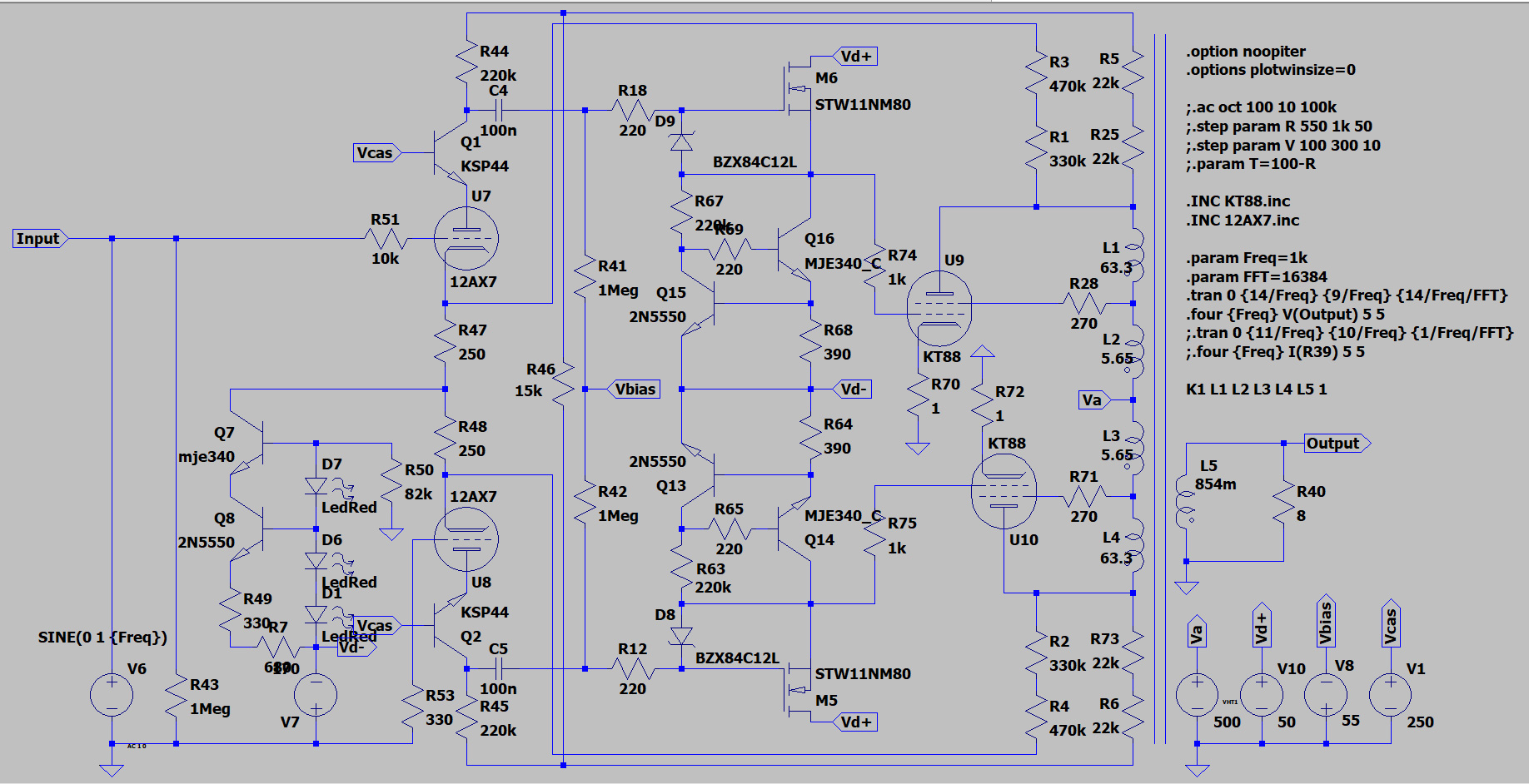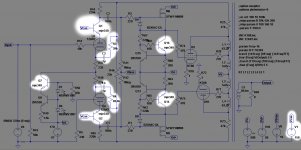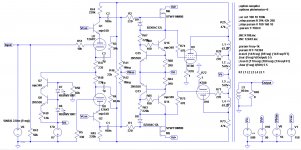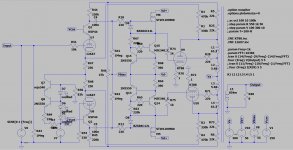IME KT88 vs 6550 there is really not much in the difference, but the different brands of tubes have some differences in tone etc. KT90 I have never tried. KT90 can run hotter but you need the power supply to supply the extra current and the power increase is not that great. I hear some people talking about using KT120, 150 etc. One issue to consider is the tube spacing on the PCBs. Running hotter and fatter tubes results in a lot of radiated heat in a small area which could be bad for tube life. I tend to run them at no more than 80% of rated plate dissipation, I think I am running the Sovtek KT88 at 70ma 400v.
Thank you Bfpca!IME KT88 vs 6550 there is really not much in the difference. I tend to run them at no more than 80% of rated plate dissipation, I think I am running the Sovtek KT88 at 70ma 400v.
I remember you suggesting to supply them at 400V to be able to run them with more current and have more Class A available. I already have 450V B+ but I'll try to drop it to see how it sounds with your suggestions.
I've no limitations on the size of the tube, because I will adapt my EL84 board to octal by installing tubes off board, so there will be enough clearance around them.
Looking at the curves in UL I'd go for 6550, but my only experience with KT88 (in a guitar amp) made me feel they have the same mids as EL84. Being a very limited experience I'll search reasonable priced tubes to test.
I've seen those two offers on ebay:
4PCS Shuguang KT88-98 Electron Tube Audio Vacuum 6550 CV5220 Fit TubeAmplifiers | eBay
New 4x Amptata 6550 KT88 | Matched Quad | Quartet | Four | Vacuum Tubes | NOS | eBay
I've read good reviews of the former, and none of the latter.
Which brands do you suggest?
Another idea I would like to apply is being able to switch between two values for the a-g1 lnfb resistor of the amp, as I've seen that resistor really makes the amp totally different. I'm thinking to a switch installed on the top of the amp, directly above R13 to be able to short a 6.8k resistor in series with 15k.
Has anyone done something similar?
Has anyone done something similar?
Bfpca,
One of the major differences between the KT88 and 6550 is the maximum allowable g1 grid resistance.
That is the total resistance to ground, or the total resistance to a stable DC voltage.
Look at the KT88 and 6550 data sheets.
For both Fixed adjustable bias, and for Self bias, the KT88 has a much higher allowable g1 resistor.
A higher g1 resistance, loads the driver much lighter, and makes the driver design much easier when using the KT88.
The 6550 lower resistance g1 resistor loads the driver more, driver gain goes down, driver distortion goes up, and driver maximum voltage swing is reduced.
The real issue, is that not all KT88 and not all 6550 tubes produced today can even meet those decades old maximum g1 resistance specifications.
The danger is Thermal Run-Away.
Poof! Burn!
It might be a case of "Plug and Play", versus "Plug and Pray".
Your Mileage May Vary.
One of the major differences between the KT88 and 6550 is the maximum allowable g1 grid resistance.
That is the total resistance to ground, or the total resistance to a stable DC voltage.
Look at the KT88 and 6550 data sheets.
For both Fixed adjustable bias, and for Self bias, the KT88 has a much higher allowable g1 resistor.
A higher g1 resistance, loads the driver much lighter, and makes the driver design much easier when using the KT88.
The 6550 lower resistance g1 resistor loads the driver more, driver gain goes down, driver distortion goes up, and driver maximum voltage swing is reduced.
The real issue, is that not all KT88 and not all 6550 tubes produced today can even meet those decades old maximum g1 resistance specifications.
The danger is Thermal Run-Away.
Poof! Burn!
It might be a case of "Plug and Play", versus "Plug and Pray".
Your Mileage May Vary.
Last edited:
Bfpca,
One of the major differences between the KT88 and 6550 is the maximum allowable g1 grid resistance.
That is the total resistance to ground, or the total resistance to a stable DC voltage.
Look at the KT88 and 6550 data sheets.
For both Fixed adjustable bias, and for Self bias, the KT88 has a much higher allowable g1 resistor.
A higher g1 resistance, loads the driver much lighter, and makes the driver design much easier when using the KT88.
The 6550 lower resistance g1 resistor loads the driver more, driver gain goes down, driver distortion goes up, and driver maximum voltage swing is reduced.
The real issue, is that not all KT88 and not all 6550 tubes produced today can even meet those decades old maximum g1 resistance specifications.
The danger is Thermal Run-Away.
Poof! Burn!
It might be a case of "Plug and Play", versus "Plug and Pray".
Your Mileage May Vary.
I didn’t have time or the inclination to get into the grid current issues. If designing for both types of tube you need to take into account the worst case load for the driver. If you use a tube strong enough to deal with the potential issue, such as ecc99 for instance, having to use 50k as a grid load resistor isn’t an issue. If you are trying to use a 12ax7, well, then you have issues. Also, I know that KT 90s were troublesome in this regard around the year 2000, so that is another reason I have never used them.
It shouldn’t be an issue with BH anyway due to the fet source follower driver. I have used 4 or 5 different KT88s over the years and had no issues. I am suspicious that some of the modern production KT88/6550 from the same manufacturer may be the same insides with different envelopes.
Thank you Bfpca!
I remember you suggesting to supply them at 400V to be able to run them with more current and have more Class A available. I already have 450V B+ but I'll try to drop it to see how it sounds with your suggestions.
I've no limitations on the size of the tube, because I will adapt my EL84 board to octal by installing tubes off board, so there will be enough clearance around them.
Looking at the curves in UL I'd go for 6550, but my only experience with KT88 (in a guitar amp) made me feel they have the same mids as EL84. Being a very limited experience I'll search reasonable priced tubes to test.
I've seen those two offers on ebay:
4PCS Shuguang KT88-98 Electron Tube Audio Vacuum 6550 CV5220 Fit TubeAmplifiers | eBay
New 4x Amptata 6550 KT88 | Matched Quad | Quartet | Four | Vacuum Tubes | NOS | eBay
I've read good reviews of the former, and none of the latter.
Which brands do you suggest?
I am not up to speed on the current production KT88/6550. Back around the year 2000 I designed a Parallel PP amp using KT88/6550. At the time I bought a lot of tubes, like maybe 60, and have not gone through them all yet. I actually sold off a bunch of them last fall and financed a turntable purchase with the proceeds. Personally, I would stick with the major brand names. If you go to TheTubeStore.com they usually have a large selection of each type and sometimes have reviews that can give you some idea of the subjective differences between brands.
This is how I would like to modify the BH circuit to use it with KT88.

Here you can see the differences with the standard circuit:

In attachment the LTSpice file.
I cascoded a BJT on top of the triode to get more gain, and added some feedback from the anode of the KT88s back to the cathode of the PI (similar to the famous 50W amp shown in Radio Designer Handbook.
UL is reduced to 23% and the "Shade" feedback resistor down to 22k.
On simulations at 82 Wrms has 2.3% of 3rd harmonic, then 5th is 20dB lower than the 3rd, 7th is 26db lower, 9th is around 34dB lower:
At 1 Wrms has 0.036% of 3rd harmonic, then all others are around 50 dB lower:
This is the most similar behaviour to my BH EL84 amp (over there DF is 2).
Calculated Damping Factor is 3 without any feedback from secondary of the output transformer back to the input.
From what I've understood here, the risk is to reinject all imperfections of the OPT back in the circuit, whilst local feedback makes each tube a "better" tube with less distortion and lower internal resistance.
I'm sure there are "right ways" to do it and to get even better results, but I'm curious to follow this path without gnfb.
Looking at the boards, I don't see easy ways to implement the two BJTs, as the traces to cut are very short and quite hidden between other components. Probably easier to do something off-board?
Has anyone suggestions for a hole-through BJT?
Thanks
Here you can see the differences with the standard circuit:
In attachment the LTSpice file.
I cascoded a BJT on top of the triode to get more gain, and added some feedback from the anode of the KT88s back to the cathode of the PI (similar to the famous 50W amp shown in Radio Designer Handbook.
UL is reduced to 23% and the "Shade" feedback resistor down to 22k.
On simulations at 82 Wrms has 2.3% of 3rd harmonic, then 5th is 20dB lower than the 3rd, 7th is 26db lower, 9th is around 34dB lower:
Code:
Harmonic Frequency Fourier Normalized Phase Normalized
Number [Hz] Component Component [degree] Phase [deg]
1 1.000e+03 3.624e+01 1.000e+00 -1.03° 0.00°
2 2.000e+03 3.856e-03 1.064e-04 -130.13° -129.09°
3 3.000e+03 8.473e-01 2.338e-02 -9.27° -8.24°
4 4.000e+03 6.817e-03 1.881e-04 -107.60° -106.56°
5 5.000e+03 8.634e-02 2.382e-03 -34.06° -33.02°
6 6.000e+03 7.278e-04 2.008e-05 -115.82° -114.78°
7 7.000e+03 4.108e-02 1.133e-03 14.43° 15.46°
8 8.000e+03 2.779e-04 7.669e-06 -49.95° -48.91°
9 9.000e+03 1.760e-02 4.856e-04 135.31° 136.34°
Total Harmonic Distortion: 2.353247%(2.353307%)At 1 Wrms has 0.036% of 3rd harmonic, then all others are around 50 dB lower:
Code:
Harmonic Frequency Fourier Normalized Phase Normalized
Number [Hz] Component Component [degree] Phase [deg]
1 1.000e+03 4.049e+00 1.000e+00 -1.22° 0.00°
2 2.000e+03 5.240e-04 1.294e-04 -97.03° -95.81°
3 3.000e+03 1.461e-03 3.610e-04 -6.94° -5.72°
4 4.000e+03 6.006e-06 1.483e-06 2.25° 3.47°
5 5.000e+03 4.318e-06 1.067e-06 24.50° 25.73°
6 6.000e+03 3.922e-06 9.686e-07 7.28° 8.50°
7 7.000e+03 3.239e-06 8.000e-07 8.25° 9.47°
8 8.000e+03 3.176e-06 7.845e-07 5.77° 7.00°
9 9.000e+03 2.604e-06 6.431e-07 7.23° 8.45°
Total Harmonic Distortion: 0.038347%(0.038323%)This is the most similar behaviour to my BH EL84 amp (over there DF is 2).
Calculated Damping Factor is 3 without any feedback from secondary of the output transformer back to the input.
From what I've understood here, the risk is to reinject all imperfections of the OPT back in the circuit, whilst local feedback makes each tube a "better" tube with less distortion and lower internal resistance.
I'm sure there are "right ways" to do it and to get even better results, but I'm curious to follow this path without gnfb.
Looking at the boards, I don't see easy ways to implement the two BJTs, as the traces to cut are very short and quite hidden between other components. Probably easier to do something off-board?
Has anyone suggestions for a hole-through BJT?
Thanks
Attachments
For tubes you can ask to Audiokit in Italy ( Aprilia), why to buy overseas?
They test the quartett very fine at reasonable price
If you are doing a fine schematic ( and I have a lot of doubt because you are playing with simulation) you have to spent some money
For OT there are in Italy some brand than can the stuff as you want at a very good level.
Walter
They test the quartett very fine at reasonable price
If you are doing a fine schematic ( and I have a lot of doubt because you are playing with simulation) you have to spent some money
For OT there are in Italy some brand than can the stuff as you want at a very good level.
Walter
I'm asking Prasi how much would it costs to mod the BHEL34 pcb for this schematic that is a mix of the BH and the RCA50W. I've done some very preliminary tests together with simulations, that seem good.

Attachments
Cascoding is for sure a good idea. But you said :
"Calculated Damping Factor is 3 without any feedback from secondary of the output transformer back to the input."
About the damping factor, you have to add the primary and secondary resistance of the transformer in simulation too.
"Calculated Damping Factor is 3 without any feedback from secondary of the output transformer back to the input."
About the damping factor, you have to add the primary and secondary resistance of the transformer in simulation too.
There is a huge output power. Why not use an ECC88 with Vp=100v ? The Gm will be around 10ma/V instead of 0,8-1 mA/V and even the two plate resistors of the cascode will be lower, the gain could be much higher. Then with, I will said, 20dB of CR, the amplifier could have stellar performances. IMHO, this is a luxe you can pay for.
CR is a common french-english acronyme and it just mean counter-reaction. But thanks for the suggestion, I'll use NF in the futur.
From the US and only speak English, I have never heard of CR and don't know what NF means either!
But I do have two Baby Hueys (BH) both using Kinless Tetrode (KT) 88s that sound wonderful using the V2 boards and a few modifications suggested by Gingertube. Your Mileage May Vary, YMMV
gabo
- Home
- Amplifiers
- Tubes / Valves
- EL34 Baby Huey Amplifier



